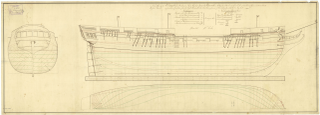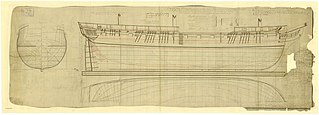Two classes of frigate have been named the Pallas class:
- Pallas-class frigate (1791), a class of three British warships designed in 1791
- Pallas-class frigate (1808), a class of fifty-seven French warships designed in 1805
Two classes of frigate have been named the Pallas class:

A frigate is a type of warship. In different eras, the roles and capabilities of ships classified as frigates have varied.
Pallas may refer to:

The Type 26 frigate, also known as City-class frigate, is a class of frigates being built for the United Kingdom's Royal Navy, with variants also being built for the Australian and Canadian navies. The programme, known as the Global Combat Ship, was launched by the British Ministry of Defence to partially replace the navy's thirteen Type 23 frigates, and for export. Its primary role is to conduct advanced anti-submarine warfare missions while supporting air defence and general purpose operations. The type is the first naval platform shared between Australia, Canada and the United Kingdom since the pre-Second World War Tribal-class destroyer.
Six ships of the Royal Navy have been named HMS Inconstant, whilst another was planned:
Six ships of the Royal Navy have been named HMS Amethyst, whilst another was planned:
Several ships of the Royal Navy have been named HMS Dragon.

HMS Minerva was a 38-gun fifth-rate Royal Navy frigate. The first of four Minerva-class frigates, she was launched on 3 June 1780, and commissioned soon thereafter. In 1798, she was renamed Pallas and employed as a troopship. She was broken up in 1803.
Five ships of the Royal Navy have been named HMS Aeolus, after one of a number of figures named Aeolus who appear in Greek mythology:

The Pallas-class frigates were a series of three frigates built to a 1791 design by John Henslow, which served in the Royal Navy during the French Revolutionary and Napoleonic Wars.
Sixteen ships of the Royal Navy have borne the name HMS Alert, while another was planned:
Seven ships of the French navy have borne the name Iphigénie, in honour of Iphigenia.
Pallada is the name of several ships of the Russian navy.

HMS Pallas was one of the three 36-gun Venus-class fifth-rate frigates of the Royal Navy. She was launched in 1757 and initially served in Sir Edward Hawke's fleet blockading the coast of France where she fought at the Raid on Cherbourg and in the Battle of Bishops Court. She later served for a number of years in the Mediterranean Sea before moving to serve off the coast of Africa between 1774 and 1776 where she protected the isolated British colonies. In 1778 she joined the Newfoundland Station and participated in the attack on Saint Pierre and Miquelon. Pallas returned to the English Channel after this and assisted in destroying a French invasion force intended for the Channel Islands in 1779 before briefly serving on the Jamaica Station. In 1783 she was beached on São Jorge Island after she was found to be heavily leaking; she was burned there on 24 February.
Five ships of the French Navy have borne the name Melpomène, in honour of the muse Melpomene.
Numerous French naval vessels have borne the name Résolue, the French for "Resolute", as have several privateers.
Fifteen ships of the French Navy have borne the name Amphitrite, after Amphitrite, a Greek sea goddess.

The Thames-class frigate was a 32-gun fifth-rate frigate class of eight ships of the Royal Navy based on the Richmond-class frigate designed by William Bately. The ships were ordered to the older design, which was of a smaller type of ship compared to more modern designs, so that they could be built quickly and cheaply in time to assist in defending against Napoleon's expected invasion of Britain. The class received several design changes to the Richmond class, being built of fir instead of oak, with these changes making the class generally slower and less weatherly than their predecessors, especially when in heavy weather conditions. The first two ships of the class, Pallas and Circe, were ordered on 16 March 1804 with two more ordered on 1 May and the final four on 12 July. The final ship of the class, Medea, was cancelled on 22 October before construction could begin but the other seven ships of the class were commissioned between 1804 and 1806.
At least two ships of the French Navy have been named Pallas:

HMS Pallas was a 36-gun fifth-rate Apollo-class frigate of the Royal Navy. Placed in ordinary when completed in 1816, Pallas was commissioned for the first time in 1828. Under Captain Adolphus FitzClarence the frigate spent time blockading the Azores before making trips to India and then Nova Scotia, conveying important passengers. The ship sailed to the Mediterranean in 1830 under the command of Captain Manley Hall Dixon, and returned early the following year with the survivors of the wreck of the Countess of Harcourt. Later in the year Pallas joined the West Indies Station, where she served until 1834 when she was paid off. In 1836 the frigate was converted into a coal hulk, in which role she served at Plymouth Dockyard until being sold in 1862.